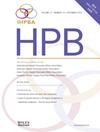Post-operative morbidity and mortality of laparoscopic cholecystectomy in patients with cirrhosis: a systematic review and meta-analysis
IF 2.4
3区 医学
Q2 GASTROENTEROLOGY & HEPATOLOGY
引用次数: 0
Abstract
Background
Patients with cirrhosis are at increased risk of gallstone disease. The objective of this review was to assess the literature to better define the perioperative risks for patients with cirrhosis undergoing laparoscopic cholecystectomy.
Methods
A systematic review was conducted using PRISMA guidelines. Inclusion criteria included papers published since 1990, with at least 25 patients with cirrhosis undergoing cholecystectomy. Outcomes of interest were post-operative liver decompensation, bile leak, surgical site infection (SSI), pneumonia, venous thromboembolism (VTE), transfusions and mortality.
Results
Forty-two papers were included with 24 575 patients, 48 % were female, with mean age of 53 years. Most patients were Child-Turcotte-Pugh A (74 %), followed by B (23 %), and C (3 %). Emergent cholecystectomy was performed in 28.7 % of patients. Post-operative liver decompensation occurred in 7.1 % (0.9–13.3, 95 % CI) of patients, superficial SSI in 1.1 % (0.6–1.5), organ space SSI in 3.7 % (2.0–5.5), bile leak in 0.7 % (0.2–1.1), VTE in 1.8 % (0.7–2.9), pneumonia in 1.9 % (1.2–2.6) and transfusions in 4 % (2.7–5.2). Post-operative mortality was 1.8 % (1.2–2.4).
Conclusion
Laparoscopic cholecystectomy is safe in most patients with cirrhosis, with notably higher complication rates compared to the general population. Continued efforts to decrease rates of bile leak, post-operative liver decompensation and mortality should be encouraged.
肝硬化患者腹腔镜胆囊切除术后的发病率和死亡率:一项系统回顾和荟萃分析。
背景:肝硬化患者发生胆结石疾病的风险增加。本综述的目的是评估文献,以更好地确定肝硬化患者行腹腔镜胆囊切除术的围手术期风险。方法:采用PRISMA指南进行系统评价。纳入标准包括1990年以来发表的至少25例肝硬化胆囊切除术患者的论文。关注的结果是术后肝脏失代偿、胆汁泄漏、手术部位感染(SSI)、肺炎、静脉血栓栓塞(VTE)、输血和死亡率。结果:纳入文献42篇,患者24575例,其中女性48%,平均年龄53岁。child - turcote - pugh A型最多(74%),其次是B型(23%)和C型(3%)。28.7%的患者行紧急胆囊切除术。术后肝脏失代偿发生率为7.1% (0.9-13.3,95% CI),浅表SSI发生率为1.1%(0.6-1.5),脏器间隙SSI发生率为3.7%(2.0-5.5),胆漏发生率为0.7%(0.2-1.1),静脉血栓栓塞发生率为1.8%(0.7-2.9),肺炎发生率为1.9%(1.2-2.6),输血发生率为4%(2.7-5.2)。术后死亡率为1.8%(1.2-2.4)。结论:腹腔镜胆囊切除术对大多数肝硬化患者是安全的,其并发症发生率明显高于一般人群。应鼓励继续努力降低胆漏、术后肝失代偿和死亡率。
本文章由计算机程序翻译,如有差异,请以英文原文为准。
求助全文
约1分钟内获得全文
求助全文
来源期刊

Hpb
GASTROENTEROLOGY & HEPATOLOGY-SURGERY
CiteScore
5.60
自引率
3.40%
发文量
244
审稿时长
57 days
期刊介绍:
HPB is an international forum for clinical, scientific and educational communication.
Twelve issues a year bring the reader leading articles, expert reviews, original articles, images, editorials, and reader correspondence encompassing all aspects of benign and malignant hepatobiliary disease and its management. HPB features relevant aspects of clinical and translational research and practice.
Specific areas of interest include HPB diseases encountered globally by clinical practitioners in this specialist field of gastrointestinal surgery. The journal addresses the challenges faced in the management of cancer involving the liver, biliary system and pancreas. While surgical oncology represents a large part of HPB practice, submission of manuscripts relating to liver and pancreas transplantation, the treatment of benign conditions such as acute and chronic pancreatitis, and those relating to hepatobiliary infection and inflammation are also welcomed. There will be a focus on developing a multidisciplinary approach to diagnosis and treatment with endoscopic and laparoscopic approaches, radiological interventions and surgical techniques being strongly represented. HPB welcomes submission of manuscripts in all these areas and in scientific focused research that has clear clinical relevance to HPB surgical practice.
HPB aims to help its readers - surgeons, physicians, radiologists and basic scientists - to develop their knowledge and practice. HPB will be of interest to specialists involved in the management of hepatobiliary and pancreatic disease however will also inform those working in related fields.
Abstracted and Indexed in:
MEDLINE®
EMBASE
PubMed
Science Citation Index Expanded
Academic Search (EBSCO)
HPB is owned by the International Hepato-Pancreato-Biliary Association (IHPBA) and is also the official Journal of the American Hepato-Pancreato-Biliary Association (AHPBA), the Asian-Pacific Hepato Pancreatic Biliary Association (A-PHPBA) and the European-African Hepato-Pancreatic Biliary Association (E-AHPBA).
 求助内容:
求助内容: 应助结果提醒方式:
应助结果提醒方式:


